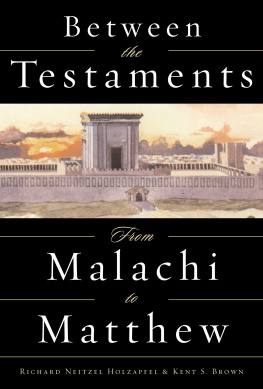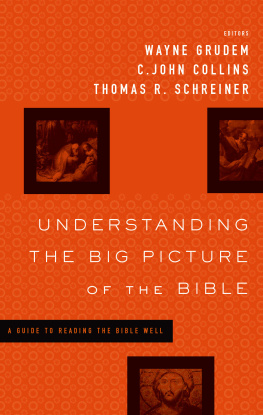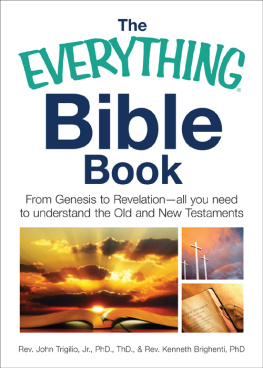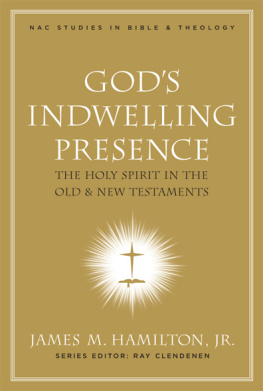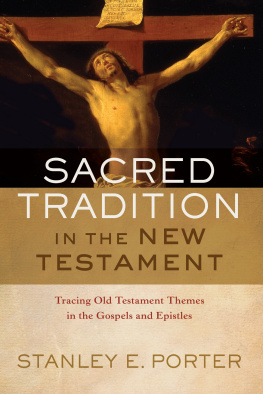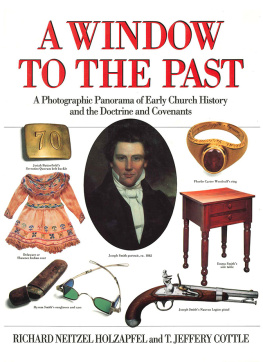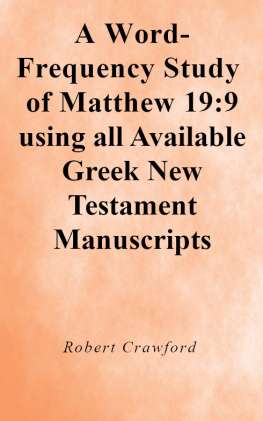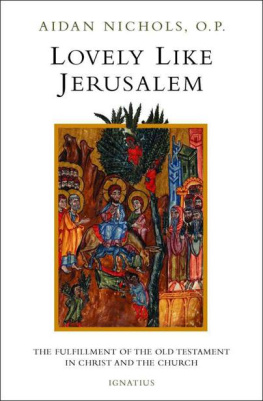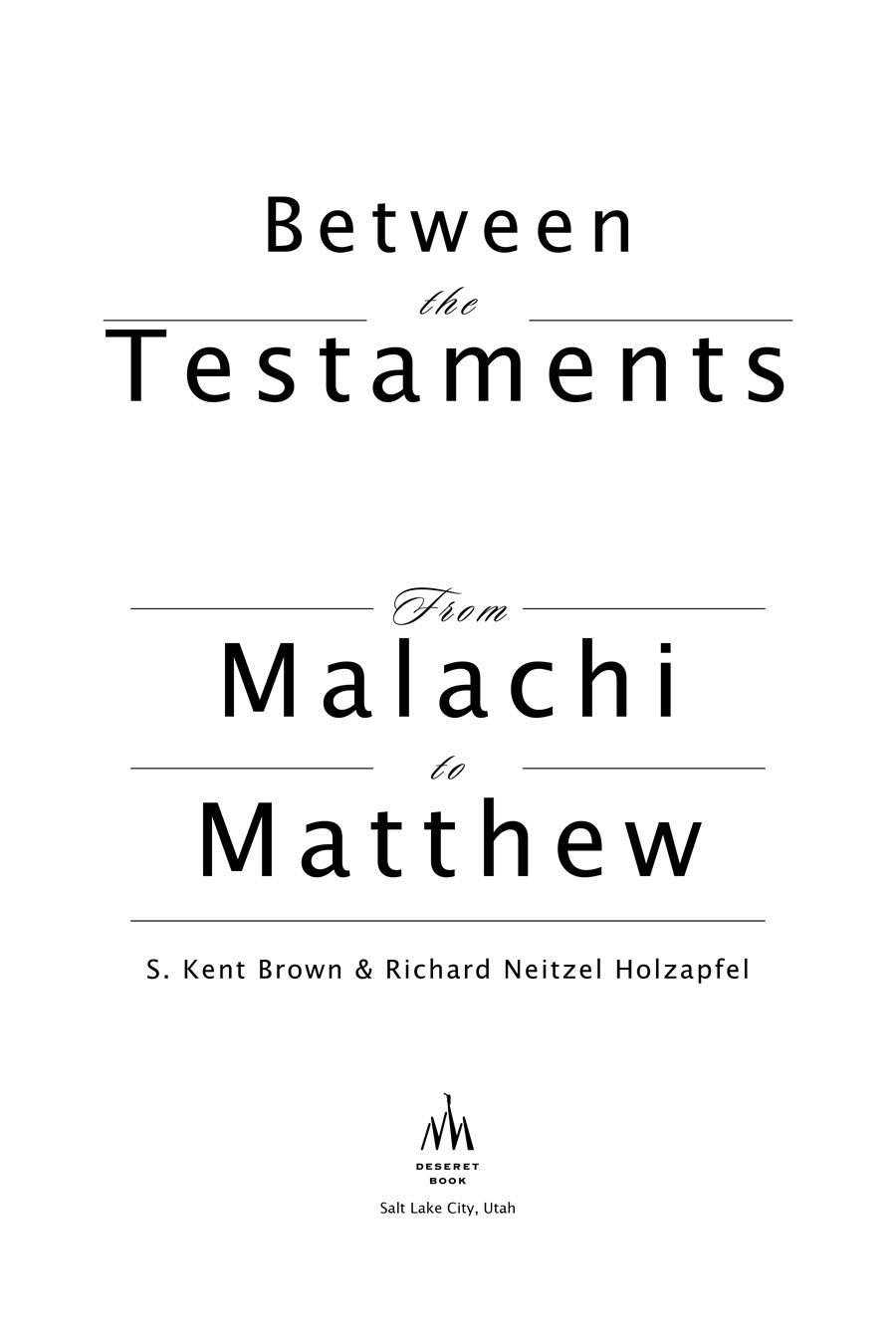2002 Kent Brown and Richard Neitzel Holzapfel.
All rights reserved. No part of this book may be reproduced in any form or by any means without permission in writing from the publisher, Deseret Book Company, P.O. Box 30178, Salt Lake City Utah 30178. This work is not an official publication of The Church of Jesus Christ of Latter-day Saints. The views expressed herein are the responsibility of the author and do not necessarily represent the position of the Church or of Deseret Book. Deseret Book is a registered trademark of Deseret Book Company.
Library of Congress Cataloging-in-Publication Data
Brown, S. Kent. Between the Testaments : from Malachi to Matthew / S. Kent Brown, Richard Neitzel Holzapfel. p. cm. Includes bibliographical references and index. ISBN 1-57008-901-9 (alk. paper) 1. Bible. O.T. ApocryphaHistory of contemporary events. 2. JudaismHistoryPost-exilic period, 586 B.C.210 A.D. I. Holzapfel, Richard Neitzel. II. Title.
BS1700 .H65 2002 220.95dc21 2002013732
Printed in the United States of America 18961-7049
R. R. Donnelley and Sons, Crawfordsville, IN
10 9 8 7 6 5 4 3 2 1

For our children
Karilynne, Julianne, Heather, Shoshauna, and Scott
S. Kent Brown
Nathan, Zac, Zanna, Marin, and Bailey
Richard Neitzel Holzapfel
Preface

Even the most casual reader of the Bible senses vast differences in the tone, texture, and doctrines of the Old and New Testaments. After reading Malachi and then turning to Matthews Gospel, we sense that more than unspoiled time has passed lazily between the end of the Old Testament period and the beginning of the New Testament. The nearly five centuries that separate the two parts of the Bible represent far more than a mere chronological divide. They also represent a hefty cultural gap.
By almost any account, an entirely new group of people rises into view within the pages of the New Testament in contrast to the group portrayed in the Old. Certainly the people, one group in the Old Testament and another in the New, inhabited the same geographical area, shared a basic religious point of view, and were of the same families and clans. Yet these two chronologically separate peoples seem deeply dissimilar in significant ways.
One obvious example of differences that we encounter between the Old and New Testaments appears in common personal names. In the Old Testament, we become familiar with the names Jacob, Joshua, Miriam, Hannah, and Elijah. In the New Testament, we read regularly of James, Jesus, Mary, Anna, and Elias. In actuality, the New Testament names are the Greek equivalents of the same names found in the Hebrew Old Testament. The case is much like the names of Paul and Pablo. They are the same name, but one is English and the other is Spanish.
However, the major differences between the Old and New Testaments do not lie simply in language. The Old Testament has come down to us in Hebrew, with a few Aramaic sections, and the New Testament comes to us in Greek. Nevertheless, the central difference between the peoples who lived at the end of the Old Testament period and those at the beginning of the New was the ever-shaping, ever-renewing passage of time. Those nearly five centuries brimmed with far-reaching changes that included periods of crippling crisis, brilliant inventiveness, cautious adaptation, and painful transition. By all odds, the major influence in that era arose from Hellenization (from Hellas, the term for Greece). By definition, Hellenization sought to repackage the world as Greek. Making its relentless influence felt initially with the coming of Alexander the Great into the Near East in the late fourth century b.c., Hellenization affected people in profound ways and explains many of the differences in tone and texture between the Old and New Testaments.
This book, Between the Testaments: From Malachi to Matthew, attempts to connect the Old and New Testaments by opening a window onto events that unfolded from the time that members of the covenant people returned from their Babylonian exile, not long before the end of the Old Testament age, to the period when Jews lived under Roman dominion at the beginning of the first century a.d., coinciding with the beginning of the New Testament era. Admittedly, one of the nettlesome challenges that faces any student of this period is the lack of sources for vast expanses of time. For these gaps, we have tried to be restrained in what we can legitimately conclude.
We introduce this period by reviewing the end of the Old Testament age before painting the story of people, places, and events between the Old and New Testaments, an era usually called the intertestamental period. We discuss the developing canon of sacred scripture and other important religious texts, such as the now-famous Dead Sea Scrolls as well as the lesser-known Apocrypha and Pseudepigrapha. We describe groups whom we meet in the New TestamentPharisees, scribes, Sadducees, priests, Samaritans, Essenes, and Zealotsall of whom either originated during this period or made important adaptations therein.
Additionally, we review the religious practices and beliefs that framed the world of the people of God during this sometimes calm, sometimes turbulent period, including their messianic hopes that pierced the frequent dark clouds of turmoil; the religious feasts and festivals that punctuated their holy calendar, joyously reminding them of ancient covenants established with Abraham, Isaac, and Jacob and renewed at Mount Sinai; and the growing Jewish law that deeply influenced peoples lives and fomented much debate and divergent practices among Jews. We end our discussion with a brief overview of the immediate setting of the birth and ministry of Jesus of Nazareth, reviewing important passages from Matthew and Luke. Finally, we provide a detailed chronology of major events.
One challenge we have faced is what to call the region in and around Jerusalem, one of the most intriguing and studied pieces of land in the world. The birthplace of two of the worlds dominant religions, Judaism and Christianity, this area has often carried the name conferred by its conquerors. For the sake of variety, we have chosen to use names from differing eras as if they were contemporaneous with one anotherJudah, Judea, Palestine, the Holy Land. Although each of these names brings forward cultural and historical peculiarities, as well as chronological differences, we decided not to be overly pedantic and have treated them as interchangeable.
To make this book reader-friendly, we decided that each chapter should stand independently as much as possible, allowing readers to choose specific topics without the necessity of reading others chapters. This decision forced us to be occasionally repetitive.
We hope this book will help readers more fully appreciate this shaping, watershed period of historythe centuries between the Old and New Testamentsfor its own sake. It was a colorful era of change and constancy and of despair and rising hopes for peoples of the Holy Land. Ultimately, we hope that Between the Testaments will also help make the Old and New Testaments into one continuous storyfrom Genesis to Revelationinstead of two stories separated by wide chasms of history, culture, and doctrine.

